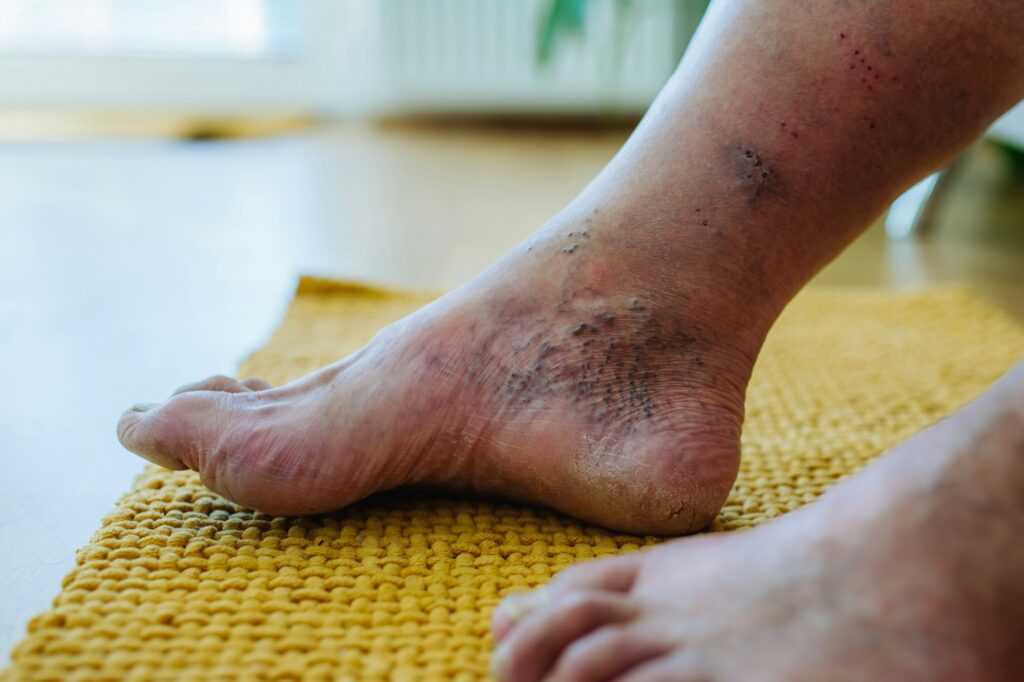Table of Contents
Diabetic Feet Treatment in the Salt Lake City area of Utah
Diabetic Foot Care
Patients with diabetes have extra risks of infections and injuries of their feet than other patients. Extra foot care and attention are then required for these patients. Our certified podiatrists have extensive experience and knowledge in diabetic foot care. We highly recommend that our diabetic patients contact us at the first sign of a foot injury.
Diabetes often causes feet to swell, which results in constricted blood flow to the feet. A diabetic’s feet can become numb and tingly. Sometimes the numbness will be so great that a patient will not feel any pain from a cut, injury or infection on his or her feet, which can lead to postponed treatment. Diabetic patients are heavily encouraged to visually examine their feet daily. Major swelling, lesions, bruising, abnormal coloring or growths. These can be signs of more serious feet problems and can become serious if not treated early.
Besides regular self-exams and office visits, there are other ways our diabetic patients can take care of their feet to keep them healthy:
- Manage your blood glucose level
- Exercise
- Invest in diabetic specific footwear
- Keep your feet clean with daily washing and drying
- Always wear shoes and socks to protect your feet
- Keep toenails trimmed short
- Be aware to avoid extreme temperatures such as hot pavement, electric blankets or wearing sandals in cold weather.
- Keep the blood flowing in your feet. Elevate your feet when sitting and constantly wiggle your toes.
If you experience diabetic feet issues, call or visit us at Advanced Foot & Ankle Center. Check out our locations page for the office nearest you. Our team of podiatrists offer a variety of feet and ankle services at affordable prices. Let us begin taking care of your diabetic feet today.
Watch this Video from Dr. David Seegmiller to Learn more about Diabetic Foot Care
Diabetic Feet FAQs
How does diabetes affect foot health?
Diabetes is a chronic disease that prevents your body from converting glucose into energy. It also causes widespread problems, including limiting circulation and damaging your peripheral nervous system.
One of the primary ways diabetes impacts foot health is by disruptions in the transmission of pain signals between your brain and the nerves in your feet. This means you can sustain cuts, abrasions, or ulcers on your feet without realizing it.
Limited circulation inhibits your body’s natural healing ability, allowing even minor sores and scrapes to quickly develop into serious wounds. Left untreated, a simple foot sore can escalate into the need for foot amputation.
When should I see a specialist for diabetic feet issues?
Diabetics have special foot health needs, and learning how to care for your feet at home is a critical part of managing diabetes. Daily foot inspections will help you catch sores, blisters, or cuts in the early stages when treatment is often most effective.
Be sure to schedule a diagnostic exam any time you notice changes in the surface of the skin on the top or bottom of your feet. You should also book a visit if you experience a significant decline in foot sensations, or notice unusual tingling, burning, or stinging.
What kinds of treatments are available for diabetic foot health?
Diabetics should work closely with a skilled podiatrist to maintain optimal foot health. Periodic diabetic foot care visits allow your doctor to check your feet for signs of damage.
These visits are customized to meet your specific needs. Treating ingrown toenails, trimming nails, or removing thickened skin are commonly performed services.
If a wound is present, your podiatrist will carefully clean the area, remove damaged tissue, and bandage the affected skin. A process called offloading may be needed to change the distribution of weight on the bottom of your foot, giving the wound a chance to heal without ongoing pressure and damage.
Advanced Foot & Ankle Center urges diabetic patients to consider coming in for wound care as opposed to visiting an emergency room where you will likely wait longer to be seen and pay significantly more for treatment.
What Should You Do Next?
Looking to schedule an appointment with a physician?
Call Advanced Foot and Ankle Center or book an appointment online today for effective solutions for diabetic feet.


